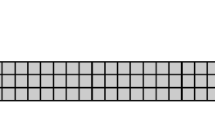Abstract
This paper extends two optimization routines to deal with objective functions for DSGE models. The optimization routines are (1) a version of Simulated Annealing developed by Corana A, Marchesi M, Ridella (ACM Trans Math Softw 13(3):262–280, 1987), and (2) the evolutionary algorithm CMA-ES developed by Hansen, Müller, Koumoutsakos (Evol Comput 11(1), 2003). Following these extensions, we examine the ability of the two routines to maximize the likelihood function for a sequence of test economies. Our results show that the CMA-ES routine clearly outperforms Simulated Annealing in its ability to find the global optimum and in efficiency. With ten unknown structural parameters in the likelihood function, the CMA-ES routine finds the global optimum in 95% of our test economies compared to 89% for Simulated Annealing. When the number of unknown structural parameters in the likelihood function increases to 20 and 35, then the CMA-ES routine finds the global optimum in 85 and 71% of our test economies, respectively. The corresponding numbers for Simulated Annealing are 70 and 0%.
Similar content being viewed by others
References
Altig, D., Christiano, L. J., Eichenbaum, M., & Linde, J. (2005). Firm-specific capital, nominal rigidities and the business cycle. NBER working paper no 11034 (pp. 1–50).
An S., Schorfheide F. (2007) Bayesian analysis of DSGE models. Econometric Reviews 26(2–4): 113–172
Andreasen, M. M. (2008). Ensuring the validity of the micro foundation in DSGE models. Working Paper.
Auger, A., & Hansen, N. (2005). A restart CMA evolution strategy with increasing population size. Proceedings of the IEEE Congress on Evolutionary Computation, CEC (pp. 1769–1776).
Christiano L.J., Eichenbaum M., Evans C.L. (2005) Nominal rigidities and the dynamic effects of a shock to monetary policy. Journal of Political Economy 113: 1–45
Corana A., Marchesi M., Ridella S. (1987) Minimizing multimodal functions of continuous variables with “simulated annealing” algorithm. ACM Transactions on Mathematical Software 13(3): 262–280
Fernández-Villaverde J., Rubio-Ramírez J.F. (2007) Estimating macroeconomic models: A likelihood approach. Review of Economic Studies 74: 1–46
Goffe W.L., Ferrier G.D., Rogers J. (1994) Global optimization of statistical functions with simulated annealing. Journal of Econometrics 60: 65–99
Hansen, N. (2005). The CMA evolution strategy: A tutorial. Working Paper.
Hansen, N., & Kern, S. (2004). Evaluating the CMA evolution strategy on multimodal test functions. In Eighth international conference on parallel problem from nature, PPSN VIII, (pp. 282–291). Berlin: Springer.
Hansen N., Müller S.D., Koumoutsakos P. (2003) Reducing the time complexity of the derandomized evolution strategy with covariance matrix adaptation (CMA-ES). Evolutionary Computation 11(1): 1–18
Justiniano A., Primiceri G.E. (2008) The time-varying volatility of macroeconomic fluctuations. The American Economic Review 98(3): 604–641
Kern S., Muller S.D., Hansen N., Buche D., Ocenasek J., Koumoutsakos P. (2004) Learning probability distributions in continuous evolutionary algorithms—A comparative review. Natural Computing 3(1): 77–112
Lagarias J.C., Reeds J.A., Wright M.H., Wright P.E. (1998) Convergence properties of the nelder-mead simplex method in low dimensions. SIAM Journal of Optimization 9(1): 112–147
Muller S.D., Hansen N., Koumoutsakos P. (2002). Increasing the serial and the parallel performance of the CMA-evolution strategy with large populations. In Seventh international conference on parallel problem solving from nature PPSN VII, Proceedings (pp. 422–431). Berlin: Springer.
Rossi G. D. (2004). Maximum likelihood estimation of the cox-ingersoll-ross model using particle filters. Working Paper.
Salamon, P., Sibani, P., & Frost, R. (2002). Facts, conjectures and improvements for simulated annealing. Philadelphia: Society for Industrial and Applied Mathematics.
Schmitt-Grohé S., Uribe M. (2004) Solving dynamic general equilibrium models using a second-order approximation to the policy function. Journal of Economic Dynamics and Control 28: 755–775
Schmitt-Grohé, S., Uribe, M. (2006). Optimal inflation stabilization in a medium-scale macroeconomic model. Working Paper (pp. 1–59).
Smets F., Wouters R. (2007) Shocks and frictions in US business cycles: A bayesian DSGE approach. American Economic Review 97(3): 586–606
Author information
Authors and Affiliations
Corresponding author
Rights and permissions
About this article
Cite this article
Andreasen, M.M. How to Maximize the Likelihood Function for a DSGE Model. Comput Econ 35, 127–154 (2010). https://doi.org/10.1007/s10614-009-9182-6
Received:
Accepted:
Published:
Issue Date:
DOI: https://doi.org/10.1007/s10614-009-9182-6
Keywords
- CMA-ES optimization routine
- Multimodel objective function
- Nelder–Mead simplex routine
- Non-convex search space
- Resampling
- Simulated Annealing




